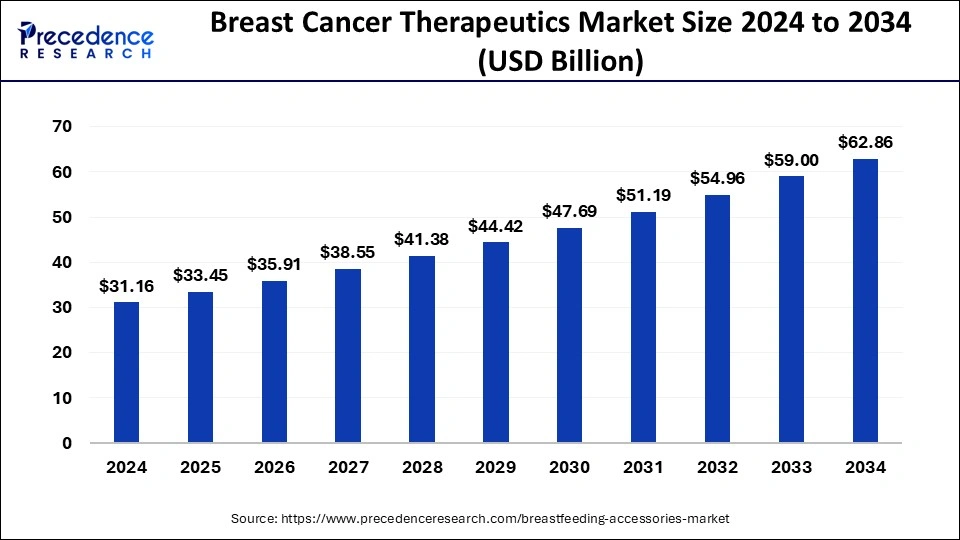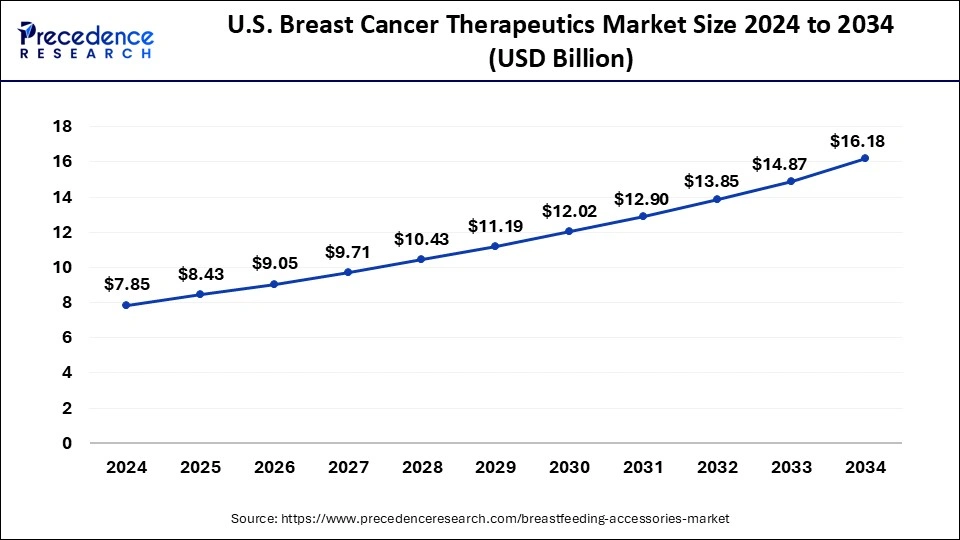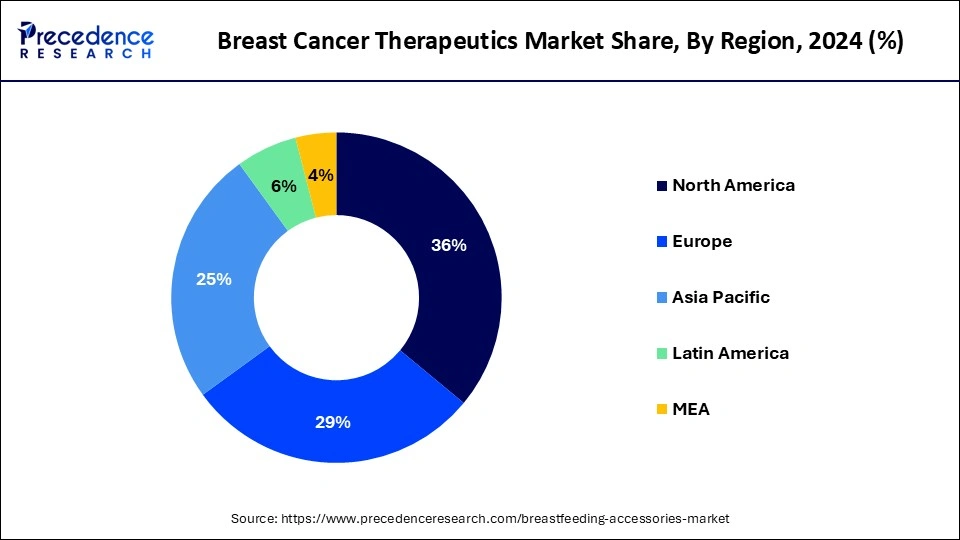What is the Breast Cancer Therapeutics Market Size?
The global breast cancer therapeutics market size accounted at USD 33.45 billion in 2025 and is predicted to increase from USD 35.91 billion in 2025 to approximately USD 62.86 billion by 2034, expanding at a CAGR of 7.27%. The increasing number of patient support initiatives globally has the potential to fuel market growth.

Market Highlights
- North America dominated the global breast cancer therapeutics market share of 36% in 2024.
- Europe is expected to hold a significant share of the market over the forecast period.
- By therapy type, the targeted therapy segment held the dominant share in 2024.
- By therapy type, the hormonal therapy segment is anticipated to show decent growth during the forecast period.
- By cancer type, the hormone receptor segment held the largest share of the market in 2024.
- By cancer type, the HER2+ segment is anticipated to show a higher CAGR in the forecast period.
- By distribution channel, the hospital pharmacies segment held the largest share of the market in 2024.
- By distribution channel, the retail pharmacies segment is anticipated to hold a significant share in the forecast period.
Market Size and Forecast
- Market Size in 2025: USD 33.45 Billion
- Market Size in 2026: USD 35.91 Billion
- Forecasted Market Size by 2034: USD 62.86 Billion
- CAGR (2025-2034): 7.27%
- Largest Market in 2024: North America
- Fastest Growing Market: Europe
Market Overview
Breast cancer, the most prevalent ailment affecting the population, predominantly targets women with proliferative disorders. Originating in breast tissues, this disease manifests through various signs such as changes in breast size and shape, nipple discharge, lumps in the breast, and irritated, scaly red spots on the skin. The expression of the human epidermal growth factor receptor 2 (HER2) gene is intricately linked to the genesis of breast cancer.
Treatment for breast cancer, known as breast cancer therapeutics, encompasses diverse approaches aimed at reducing or eliminating cancer cells within the breast. These interventions comprise chemotherapy, deploying specific drugs to eradicate cancer cells; radiation therapy, utilizing high-energy rays to obliterate cancer cells; and hormone therapy, inhibiting cancer cell growth by blocking crucial hormones.
Breast Cancer Therapeutics MarketGrowth Factors
- The breast cancer therapeutics market is anticipated to experience substantial growth, propelled by increasing global incidence rates of breast cancer, advancements in treatment methods, and heightened awareness regarding early detection.
- Key growth drivers of the breast cancer therapeutics market encompass the expansion of novel therapeutic pipelines, particularly in targeted and immunotherapies, promising more efficient and less toxic treatment options.
- Partnerships between companies, research institutions, and healthcare providers are boosting the creation of new treatments and making them more accessible.
- Besides supporting programs for breast cancer screening, numerous governments globally are dedicating resources to research, treatment, and raising awareness about the condition, driving the breast cancer therapeutics market.
Market Scope
| Report Coverage | Details |
| Market Size in 2025 | USD 33.45 Billion |
| Market Size in 2026 | USD 35.91 Billion |
| Market Size by 2034 | USD 62.86 Billion |
| Growth Rate from 2025 to 2034 | CAGR of 7.27% |
| Base Year | 2025 |
| Forecast Period | 2025 to 2034 |
| Segments Covered | Therapy, Cancer Type, Distribution Channel, and Region |
| Regions Covered | North America, Europe, Asia-Pacific, Latin America, and Middle East & Africa |
Market Dynamics
Drivers
Disparities in cancer care and treatment
Disparities in cancer care and treatment access highlight the urgent need for improved global healthcare infrastructure and services. Disparities in cancer outcomes are linked to human development levels, with countries having lower Human Development Index (HDI) facing higher breast cancer mortality rates due to late diagnosis and inadequate access to quality treatment. These findings underscore the importance of addressing cancer inequities and investing in comprehensive cancer care infrastructure to enhance outcomes for breast cancer patients worldwide, potentially contributing to the growth of the breast cancer therapeutics market.
- The World Health Organization's (WHO) survey on Universal Health Coverage (UHC) and cancer revealed significant gaps in cancer management and palliative care services across participating countries. Only 39% of countries included the basics of cancer management in their core health services for all citizens.
Restraint
High treatment costs
The significant expenses linked to breast cancer therapeutics pose challenges to accessibility in the breast cancer therapeutics market, especially in areas with constrained healthcare resources. For example, advanced targeted treatments like trastuzumab (Herceptin) may impose a financial burden on numerous patients, limiting their ability to afford crucial treatments. Inequities in access persist, with underserved populations encountering difficulties in obtaining timely diagnoses and suitable therapies due to restricted healthcare infrastructure and geographical obstacles.
Opportunities
Advancements in targeted therapies and immunotherapies improve breast cancer patient outcomes
Advancements in the diagnosis and treatment of breast cancer are propelling the growth of the breast cancer therapeutics market. Targeted therapies and immunotherapies have transformed breast cancer treatment, providing more effective and less toxic options for patients. Additionally, the global cancer burden, including breast cancer, is increasing, with a surge in new cases and deaths fueling market expansion.
- According to the World Health Organization (WHO), there were approximately 20 million new cancer cases and 9.7 million deaths worldwide in 2022. Breast cancer stands as the second most common cancer globally, with around 2.3 million new cases, accounting for 11.6% of total new cancer cases. It is a significant cause of cancer-related deaths, with 670,000 reported deaths in 2022, constituting 6.9% of total cancer deaths.
Advancement in diagnosis
The breast cancer therapeutics market is moving towards more focused and accurate treatments like HER2-targeted and hormone therapies. These advances have enhanced patient outcomes and survival rates. Additionally, there's a rise in the development of immunotherapies and combination therapies, providing new treatment choices with improved effectiveness. Furthermore, government support, research and development investments, and collaborations between pharmaceutical companies and research institutions drive market growth.
- In May 2022, Roche introduced PHESGO to treat HER-2-positive breast cancer in India. PHESGO is the first-ever fixed-dose formulation in cancer treatment, combining two monoclonal antibodies. This innovative approach aims to enhance the effectiveness of breast cancer treatment.
Segments Insights
Therapy Type Insights
The targeted therapy segment held the dominant share of the breast cancer therapeutics market in 2024. Targeted therapy has become increasingly prominent due to its efficacy and fewer side effects than traditional chemotherapy. In breast cancer, targeted drug therapy involves medications directed at specific proteins in cancer cells, hindering their growth, spread, and longevity. These drugs aim to destroy cancer cells or impede their growth, exhibiting different side effects than chemotherapy. Trastuzumab demonstrated improved overall survival in late-stage breast cancer, extending from 20.3 to 25.1 months. In early-stage breast cancer, it reduced the risk of cancer recurrence after surgery by 9.5% and the risk of death by 3%.
The hormonal therapy segment is anticipated to show decent growth during the forecast period. Hormone therapy has become a crucial component in breast cancer treatment, particularly for estrogen receptor-positive tumors, leading to a significant reduction in recurrence rates. This therapy, also known as hormonal therapy or endocrine therapy, hinders the growth of hormone-sensitive tumors by either blocking the body's hormone production or interfering with hormones' effects on breast cancer cells. Typically administered after surgery to lower the risk of cancer recurrence (adjuvant therapy), it may also be initiated before surgery (neoadjuvant treatment).
The standard duration is at least five years. In some cases, therapy beyond five years might be recommended based on the likelihood of cancer recurrence, determined by tests like the breast cancer Index. Hormone therapy is also employed to treat cancer that has returned after initial treatment or has spread to other parts of the body.
Cancer Type Insights
The hormone receptor segment held the largest share of the breast cancer therapeutics market in 2024. Hormone receptors, which are large protein molecules located on target cells, play a crucial role in cell communication. Each cell typically has thousands of these receptors, and an essential feature is their specificity—each receptor can recognize only one hormone. Therefore, a hormone's corresponding receptor must be present to exert its effects on a target cell, in the context of breast cells, hormone receptors, specifically estrogen or progesterone, act as signal receivers, promoting cell growth. This includes the growth of cancer cells if they possess the receptors for these hormones.
The HER2+ segment is anticipated to show a higher CAGR in the breast cancer therapeutics market over the forecast period. This is attributed to recent product launches and market acquisitions. In breast cells, an excess of human epidermal growth factor receptor 2 (HER2) is a common feature tested for. HER2 proteins are receptors that govern the growth and division of cells. If there is an overexpression of HER2 receptors in breast tissue, it can lead to an accelerated multiplication of breast cells.
An article from Cancer Therapy Advisor in December 2023 suggests that a potential new standard of care for individuals with PIK3CA-mutant, hormone receptor (HR)-positive, HER2-negative advanced breast cancer could involve combining Inavolisib with palbociclib and fulvestrant. In the phase 3 INAVO120 trial, researchers observed that adding Inavolisib to this treatment combination doubled the median progression-free survival (PFS).
Distribution Channel Insights
The hospital pharmacies segment held the dominating share of the market in 2024, the segment is observed to sustain the position in the breast cancer therapeutics market during the forecast period. This is attributed to the growing dependence of patients on chemotherapy-related drugs. The demand for breast cancer treatments will increase during this period, fueled by rising patient needs for diverse pharmaceuticals. Furthermore, improved accessibility to these products in hospital pharmacies contributes to the anticipated market expansion.
- In November 2023, Aster Royal Al Raffah Hospital in Oman took a significant step in healthcare by launching the Aster Al Raffah Breast Cancer Clinic. This specialized facility is dedicated to early detection and comprehensive management of breast cancer and related disorders.
The retail pharmacies segment is anticipated to hold a significant share in the forecast period. Pharmacists have a significant role in managing postmenopausal breast cancer and vasomotor symptoms. They contribute by educating patients and suggesting medications in line with treatment guidelines. This involves considering potential side effects and drug interactions.
Regional Insights
U.S.Breast Cancer Therapeutics Market Size and Growth 2025 to 2034
The U.S. breast cancer therapeutics market size is exhibited at USD 8.43 billion in 2025 and is projected to be worth around USD 16.18 billion by 2034, growing at a CAGR of 7.50%.

North America led the market with the biggest market share of 36% in 2024. Ongoing research initiatives supported by organizations like Susan G. Komen enhance our understanding of breast cancer biology and improve treatment outcomes. Furthermore, regulatory approvals, such as the FDA's authorization of Trodelvy for treating triple-negative breast cancer, indicate ongoing progress in therapeutic innovation and patient care in North America.
- In the U.S., approximately 1 in 8 women are affected by breast cancer during their lifetime, and it is expected that around 287,850 new cases of invasive breast cancer will be diagnosed among women in 2022. It's worth noting that breast cancer also affects men, with an estimated 2,710 new cases projected for the same year.
- In August 2022, the U.S. Food and Drug Administration gave the green light to Enhertu (fam-trastuzumab-deruxtecan-nxki), an intravenous infusion designed to treat individuals with HER2-low breast cancer that is either inoperable or has spread to other parts of the body.

Europe is expected to hold a significant share of the breast cancer therapeutics market over the forecast period, mainly due to the rising incidence of breast cancer and increased adoption of advanced therapies. Among European countries, breast cancer is a prevalent form, accounting for about 523,000 new cases, which is 13% of all cancer cases in the region. Other common types of cancer include colorectal, lung, and prostate cancers. Despite improvements in healthcare infrastructure and cancer management, Europe faces challenges like demographic shifts, healthcare access issues, and disparities in cancer outcomes among different population groups.
The Asia Pacific breast cancer therapeutics market is expanding significantly due to factors like customized medication, advancement in immunotherapy, drug delivery systems, liquid biopsies, and patient-centric initiatives shaping the market further. On a country level, China and Japan are expected to witness a significant growth rate for the breast cancer therapeutics market due to advancements in treatment options for breast cancer. On the other hand, the Japanese market is propelling due to geriatric population treatment options, initiatives, and policies offered by government bodies, technological advancement, with high health expenditure, shaping the market's future.
Breast Cancer Therapeutics Market Companies
- Pfizer (USA)
- Novartis (Switzerland)
- Roche (Switzerland)
- AstraZeneca (UK)
- Eli Lilly and Company (U.S.)
- Merck & Co., Inc. (U.S.)
- Bristol-Myers Squibb (U.S.)
- Sanofi (France)
- Johnson & Johnson (U.S.)
- AbbVie Inc. (U.S.)
- Gilead Sciences (U.S.)
- Celgene Corporation (U.S.)
- Eisai Co., Ltd. (Japan)
- Takeda Pharmaceutical Company Limited (Japan)
- Amgen Inc. (U.S.)
- Teva Pharmaceutical Industries Ltd. (Israel)
- Mylan N.V. (U.S.)
- Daiichi Sankyo Company, Limited (Japan)
- Otsuka Pharmaceutical Co., Ltd. (Japan)
- Ipsen (France)
Recent Developments
- In April 2025, a clinical-stage biopharmaceutical company having share of USD 103 Atossa Therapeutics, Inc., unveiled the acceptance of a new patent by the U.S. Patent and Trademark Office for its formulation for breast cancer treatment. The patent incorporates nearly 58 claims about formulations, purity, and stability, along with methods used for the precise treatment of breast cancer. (Source: https://za.investing.com)
- In May 2025, Mersana, aiming to develop a pipeline of antibody drug conjugates to target cancers in underserved areas, revealed that the implementation of a strategic restructuring and reprioritization plan to extend the company's cash runway, along with emlitatug ledadotin product development. (Source: https://za.investing.com)
- In May 2025, Zetagen Therapeutics, Inc., announced its aims for the development of breakthrough therapies with the help of local administration for primary and metastatic breast cancers, unveiled that they have completed enrollment in their phase 2a study, which helps evaluate ZetaMet, specially made for the treatment of lytic breast cancer lesions successfully. (Source: https://www.businesswire.com)
- In February 2023, GenoPharma Inc. completed Phase III clinical trials for their new targeted therapy for HER2-positive breast cancer.
- In April 2023, MedSolution Pharmaceuticals introduced a groundbreaking immunotherapy treatment for triple-negative breast cancer called ImmunoClearTM. This therapy utilizes the patient's immune system to target and eliminate cancer cells selectively, leading to improved response rates and extended progression-free survival.
- In June 2023, Global Biotech Corporation launched a precision medicine approach for hormone receptor-positive breast cancer, improving treatment outcomes and reducing side effects.
- In September 2022, Novartis announced results from a new pooled exploratory analysis across the entire MONALEESA Phase III program, confirming nearly one year of additional overall survival (OS) benefit in a subgroup of patients with aggressive forms of hormone receptor-positive, human epidermal growth factor receptor-2 negative (HR+/HER2-) advanced breast cancer (ABC).
Segments Covered in the Report
By Therapy
- Targeted Therapy
- Abemaciclib
- Ado-Trastuzumab Emtansine
- Everolimus
- Trastuzumab
- Ribociclib
- Pertuzumab
- Olaparib
- Others
- Hormonal therapy
- Selective estrogen receptor modulators
- Aromatase inhibitors
- Estrogen receptor downregulation
- Chemotherapy
- Immunotherapy
By Cancer Type
- Hormone Receptors
- HER2+
By Distribution Channel
- Hospital Pharmacies
- Retail Pharmacies
- Online Pharmacies
- Others
By Region
- North America
- Europe
- Asia-Pacific
- Latin America
- Middle East and Africa
For inquiries regarding discounts, bulk purchases, or customization requests, please contact us at sales@precedenceresearch.com
Frequently Asked Questions
Ask For Sample
No cookie-cutter, only authentic analysis – take the 1st step to become a Precedence Research client
 sales@precedenceresearch.com
sales@precedenceresearch.com
 +1 804-441-9344
+1 804-441-9344